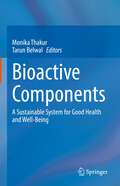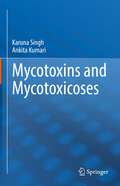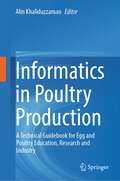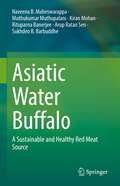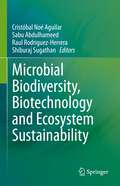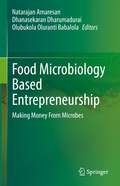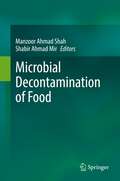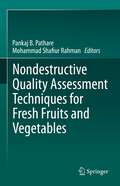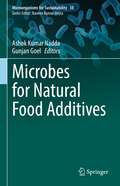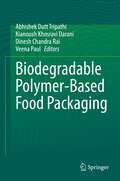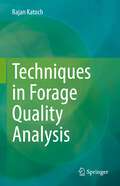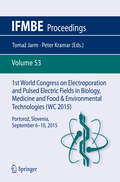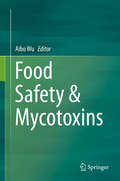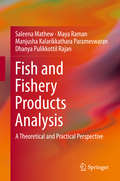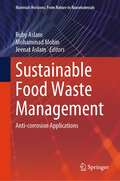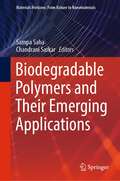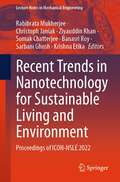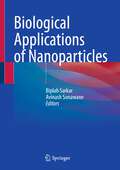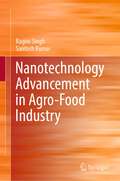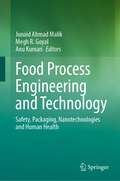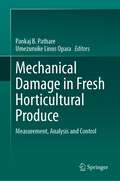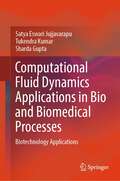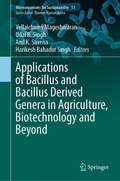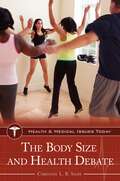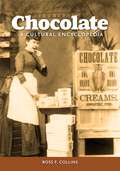- Table View
- List View
Bioactive Components: A Sustainable System for Good Health and Well-Being
by Monika Thakur Tarun BelwalThis book compiles updated information about the role and health benefits of various bioactives in food. Different chapters are contributed by academicians, food scientists, technologists, and medical practitioners. The book addresses both theoretical and applied aspects of bioactive components and provides exhaustive knowledge about bioactive components. It comprises 27 chapters organized into 4 major sections covering topics in food science and technology, functional foods, and nutraceuticals. It provides perspectives for innovation, sources, applications, and sustainability in bioactive component research. The first section starts with introduction of bioactive components consisting of seven different chapters primarily focusing on the bioactive components and their sources with respective health benefits. The second section, comprising five different chapters, deals with different technological trends, regulations, and safety aspects of bioactive components. With eight chapters, the third section covers the role of bioactive components in human health and the role of functional foods in combating various health-related issues. The fourth section reviews functional foods through six chapters that cover the use of bioactive components in various food products. The book will prove useful to advanced food technology graduate and undergraduate students and research scholars, practicing food technologists in food and related industries, entrepreneurs, food-pharma researchers, and other scientists seeking information about smart and sustainable processes as well as information needed to design and develop these processes.
Mycotoxins and Mycotoxicoses
by Karuna Singh Ankita KumariThis book presents a comprehensive view on mycotoxins of agricultural as well as non-agricultural environments and their health effects in humans and animals. Mycotoxins have immunosuppressive effects; but some of them can cause cancers, mutagenicity, neurotoxicity, liver and kidney damage, birth defects, DNA damage and respiratory disorders. The problem of mycotoxins is long-lasting and their direct or indirect exposures to humans and animals must be further discussed. The first chapter will cover the historical perspective of mycotoxins along with timeline while the second one will provide overview including classification of mycotoxins and mycotoxicoses. The comprehensive information/ literature on traditional, emerging and mushroom mycotoxins will be given in chapters 3, 4 and 5 respectively. Chapter 6 will deal with mycotoxins co-occurrence poisoning whereas new and masked mycotoxins will be described in chapter 7. The important aspects of mycotoxin studies like extraction, characterization and analysis and management strategies will be summarized in 8 and 9 chapters. The last chapter of the book will cover the recent developments in toxicokinetic studies of mycotoxins. The book will have the most up-to-date information and recent discoveries to deliver accurate data and to illustrate essential points to a wide range of readers including mycologists, clinicians, agricultural scientists, chemists, veterinarians, environmentalists and food scientists.
Informatics in Poultry Production: A Technical Guidebook for Egg and Poultry Education, Research and Industry
by Alin KhaliduzzamanThis book discusses table and hatching eggs, quality-based grading of eggs, pre-incubation, incubation, hatching and post-hatch monitoring period, and how the next-generation management of these process can be enriched by informatics through non-destructive technologies, signal processing, machine learning, AI, IoT applications, etc. This book will be a beneficial resource for egg and poultry science researchers, avian biologists and ecologists, developmental biologists, agricultural engineers, advanced graduate and postgraduate students, and poultry production industry stakeholders.
Asiatic Water Buffalo: A Sustainable and Healthy Red Meat Source
by Naveena B. Maheswarappa Muthukumar Muthupalani Kiran Mohan Rituparna Banerjee Arup Ratan Sen Sukhdeo B. BarbuddheThis need-based unique book deals exclusively with water buffalo (Bubalus bubalis) meat to provide much needed information to thousands of buffalo meat processors across the world. The information provided in this first-of-its-kind book on buffalo meat quality, nutritional characteristics, safety, and processing can be utilized by buffalo meat producers and meat processors for the advancement of the buffalo meat sector. It also provides valuable information to faculty members, students, researchers, and all other readers interested in this new source of meat. Owing to the limited research and scientific literature available on buffalo meat, the authors’ own research findings and our experiences were included wherever required to give crisp, practical, and complete information. The information proposed in this book should be beneficial to the entire buffalo industry, from the farming and processing of buffaloes to the marketing of products. This serve as a handy guide to meat scientists, faculty members, and students willing to learn more about buffalo meat processing. Up-to-date relevant references were also included for the benefit of researchers and students to enable them to easily access further information. Above all, it provides valuable information to consumers who are interested to know this new and potential source of meat.
Microbial Biodiversity, Biotechnology and Ecosystem Sustainability
by Cristóbal Noé Aguilar Sabu Abdulhameed Raul Rodriguez-Herrera Shiburaj SugathanThis book gives insight into several aspects of the microbiology, biotechnology, and ecosystem sustainability of special and under-explored regions, that captivate human beings by their natural richness, their extensive biodiversity, the extraordinary forms of adaptation of the living beings that they inhabit, and even that keep living secrets as is the very origin of life. The chapters emphasize all aspects of biological diversity-its description, analysis, and conservation, and its controlled rational use by humankind. Also, the book is elaborated from a wide and multidisciplinary point of view. It presents reviews, research papers, comments, and research notes on biodiversity, ethnobiology, geoscience, chemistry, biological conservation, biotechnology, and ecosystem sustainability Two hotspots are the reference for this enriching book that describes details of extraordinary areas of the planet, from Cuatrociénegas, Coahuila (Mexico) to the Southern Western Ghats (India). The book will contribute to dealing with the practicalities of conservation management, economic, social, and political issues. It provides a forum for examining conflicts between sustainable development and human dependence on biodiversity in agriculture, environmental management, and biotechnology, and encourages contributions from developing countries to promote broad global perspectives on matters of biodiversity and conservation.
Food Microbiology Based Entrepreneurship: Making Money From Microbes
by Natarajan Amaresan Dhanasekaran Dharumadurai Olubukola Oluranti BabalolaThis book is first part of the 3 volume set focusing on basic and advanced methods for using microbiology as an entrepreneurial venture. This book deals with the concept of entrepreneurship skills for production, cost-benefit analysis and marketing of button, oyster, milky mushroom, Ganoderma sp, Single cell protein, Breads, Cheese, Yoghurt, Wine, Beer, Probiotics, Prebiotics fermented vegetables, and Fermented Fish etc. Chapters cover the applications of microorganisms in small and large scale production to achieve a sustainable output. This book provides essential knowledge and working business protocols from all related disciplines of food and dairy industry, probiotics industry, mushroom industry, beverage and baking industry, poultry industry, and aquaculture industry etc. This book is useful to graduate students, research scholars and postdoctoral fellows, and teachers who belong to different disciplines via botany, food microbiology, biotechnology, aquaculture microbiology and poultry microbiology. The other two volumes are focused on agriculture and industrial microbiology.
Microbial Decontamination of Food
by Manzoor Ahmad Shah Shabir Ahmad MirFood is contaminated in the production chain and is the point of concern among the consumers and industries. There is also a considerable increase in foodborne outbreaks, which possess the challenge to industry associated with the production of processed food. Various strategies are used to prevent the contamination during postharvest stage, storage and distribution. Different methods are exploited for degrading or eliminating the microbial contamination from food commodities. The conventional techniques used for decontamination demanded a considerable requirement for novel technologies, which are efficient, environmental friendly, and cost-effective. Novel technologies efficiently remove the contamination without adversely affecting the nutritional properties and sensory characteristics of food material. There is a lack of scientific information on the microbial decontamination of different food commodities such as fruits, vegetables, cereals, sprouts, microgreens, meat, poultry, milk, nut, spices etc. under one umbrella. The application of conventional and novel technologies for improving the food safety of individual food commodities will be addresses in this book. Written by several experts in the field, this book is a valuable source for students, scientists, and professionals in food science, food microbiology, food technology, food processing, and other allied sciences.
Nondestructive Quality Assessment Techniques for Fresh Fruits and Vegetables
by Pankaj B. Pathare Mohammad Shafiur RahmanThis book describes the various techniques for nondestructive quality assessment of fruits and vegetables. It covers the methods, measurements, operation principles, procedures, data analysis, and applications for implementing these techniques.The book presents the details of nondestructive approaches focusing on the present-day trends and existing future opportunities in the fresh food supply chain. First, it overviews different nondestructive techniques in food quality detection. Then it presents nondestructive methods: monochrome computer vision, imaging techniques, biospeckle laser technique, Fourier Transform Infrared (FTIR) Spectroscopy, hyperspectral imaging, Raman spectroscopy, near infrared (NIR) spectroscopy, X-ray computed tomography, ultrasound, acoustic emission, chemometrics, electronic nose and tongue. Selected applications of each method are also introduced. As a result, readers gain a better understanding of how to use nondestructive methods and technologies to detect the quality of fresh fruits and vegetables.With a wide range of interesting topics, the book will benefit readers including postharvest & food scientists/technologists, industry personnel and researchers involved in fresh produce quality detection. The book can also serve as a readily accessible reference material for postgraduate students.
Microbes for Natural Food Additives (Microorganisms for Sustainability #38)
by Ashok Kumar Nadda Gunjan GoelThis book provides all the aspects of microbes for food additives, and a detailed description of their different categories. The chapters provide a step-by-step overview of microbial food additives as enzymes, antioxidants, stabilizers, emulsifiers, organic acids, colorants, sweeteners, flavoring compounds that have been used commercially by industrialists. In addition, an emphasis on the use of microbes as therapeutic agents such as probiotics and enzymes have also been given in the respective chapters. Furthermore, the book also comprises the detailed description of legislation and policies for the use of microbial additives at large scale in different food industries. Therefore, this book provides a comprehensive, state of art updated literature which can be used by the food scientists, nutritionists, microbiologists and a health-conscious layman to check the food additive list on a product for a nutritious and safer food.
Biodegradable Polymer-Based Food Packaging
by Abhishek Dutt Tripathi Kianoush Khosravi Darani Dinesh Chandra Rai Veena PaulThis book covers different aspects of biodegradable packaging, such as their sourcing and application in food industries. The book focuses on the production and characterization of biodegradable food packaging derived from plant, animal and microbial sources. Chapters highlight the nano-technological interventions in biodegradable food packaging and the less studied microbial biopolymer-based biodegradable food packaging makes it distinct from other related books. It includes the latest research and development in the areas of food processing, food packaging, material science and polymeric science. It also discusses the standards and regulatory guidelines about the biodegradability testing of these polymers.This book is meant for researchers in food science, food packaging, bioprocess technology, polymer science and biochemical engineering. It is also beneficial for faculty members and students of food microbiology, food technology, dairy technology. The book is also meant for small entrepreneurs and farmers who are interested in bio-plastic usage for food packaging.
Techniques in Forage Quality Analysis
by Rajan KatochThe book covers different techniques and methodologies involved in the nutritional quality analysis of forages. It also discusses the nutritional quality, anti-nutritional components, factors affecting forage quality, feed processing and conservation. Different techniques and methodologies have been presented in a simplified manner. The book has been divided in separate chapters and each chapter discusses different aspect of forage quality. Further, the book also covers the topics on conservation and processing of forages and management techniques for improving the forage nutritional quality. This book is an essential source of information for research scholars, post-graduate students and scientists working on forage quality estimation and also in livestock and dairy industries.
1st World Congress on Electroporation and Pulsed Electric Fields in Biology, Medicine and Food & Environmental Technologies: Portorož, Slovenia, September 6 –10, 2015 (IFMBE Proceedings #53)
by Tomaz Jarm Peter KramarThis volume presents the proceedings of the 1st World Congress on Electroporation and Pulsed Electric Fields in Biology, Medicine and Food & Environmental Technologies (WC2015). The congress took place in Portorož, Slovenia, during the week of September 6th to 10th, 2015. The scientific part of the Congress covered different aspects of electroporation and related technologies and included the following main topics: · Application of pulsed electric fields technology in food: challenges and opportunities· Electrical impedance measurement for assessment of electroporation yield· Electrochemistry and electroporation· Electroporation meets electrostimulation· Electrotechnologies for food and biomass treatment· Food and biotechnology applications· In vitro electroporation - basic mechanisms· Interfacial behaviour of lipid-assemblies, membranes and cells in electric fields· Irreversible electroporation in clinical use· Medical applications: electrochemotherapy· Medical applications: gene therapy· Non-electric field-based physical methods inducing cell poration and enhanced molecule transfer· Non-thermal plasmas for food safety, environmental applications and medical treatments· PEF for the food industry: fundamentals and applications· PEF process integration - complex process chains and process combinations in the food industry· Predictable animal models· Pulsed electric fields and electroporation technologies in bioeconomy· Veterinary medical applications
Food Safety & Mycotoxins
by Aibo WuMycotoxins are increasingly attracting attention at thegovernmental, public and academic level worldwide, due to more frequent and serious contaminations of food and feedstuffs, which pose a serious threat to human health and animal production. This book reviews the latest research on mycotoxins that directly concern food safety, and especially focuses on detection technologies, risk assessment and control strategiescurrently being used in China. Gathering contributions from over 20 respected researchers, the book will benefit graduatestudents, researchers and management groups from various disciplines, including food science and technology, analytical chemistry, plant pathology, public health, etc.
Fish and Fishery Products Analysis: A Theoretical and Practical Perspective
by Saleena Mathew Maya Raman Manjusha Kalarikkathara Parameswaran Dhanya Pulikkottil RajanThis novel and informative book discusses the various aspects of seafood quality. The book is divided into 7 broad sections, each tackling a different aspect. The first section covers the general aspects relevant to the nutritional quality of the fish and the various extraction protocols for macro-/ micro-nutrients. The second section provides insights into handling and the principles of thermal and non-thermal processing techniques for commercially important fishery products. The quality standards and safety concerns in the seafood industry and consumption are discussed in this section. The freshness indices of the processed products including biochemical, microbiological and toxicological characteristics are also included. The third section discusses the physico-chemical characteristics and quality parameters of potable water/ ice. The fourth section includes the quality assessment of various toxicants related to seafood products. The fifth section deals with the specific aspects such as principle, instrument and procedures of conventional and novel analytical instruments relevant to the seafood industry. The sixth section deals with the seafood waste management including solid and liquid seafood wastes. Presently, there is a great awareness regarding environmental sustainable processing/ preservation techniques. The final chapter discusses the bioactive compounds from under-utilized marine sources showing pharmaceutical/ nutraceutical applications.
Sustainable Food Waste Management: Anti-corrosion Applications (Materials Horizons: From Nature to Nanomaterials)
by Ruby Aslam Mohammad Mobin Jeenat AslamThis book highlights established research and technology on corrosion inhibitors and bio-waste management. It further discusses emerging aspects of utilizing food waste in the field of corrosion inhibition. The topics covered include overview on bio-waste and their management, different types of food waste (i.e., agricultural, vegetable and fruit/fruit juice, plant waste, slaughterhouse trash), and their application as corrosion inhibitors and mitigation of corrosion. It also discusses economic aspects and commercialization of food waste as corrosion inhibitors. The book is a valuable reference for beginners, researchers, and professionals working in the areas of sustainability, food waste management, and material science.
Biodegradable Polymers and Their Emerging Applications (Materials Horizons: From Nature to Nanomaterials)
by Sampa Saha Chandrani SarkarBio-degradable polymers are rapidly emerging as a sustainable alternative to traditional petroleum-based plastics and polymers. However, the synthesis and processing of such polymers present unique challenges and opportunities. In this comprehensive volume, Dr. Saha and her team provide an in-depth exploration of the synthesis and processing of bio-degradable polymers and their emerging applications in various sectors from drug delivery to food packaging. Covering a wide range of topics, including synthesis, modification, processing techniques, and few of their advanced applications in emerging areas, this book provides a comprehensive overview of the field. The authors also delve into cutting-edge research on the synthesis, properties and applications of bio-degradable polymers in various fields, such as agricultural, food preservation, biomedical arena, energy storage and other advanced application areas. This volume is an essential resource for scientists, engineers, and policymakers interested in the future of sustainable materials. Whether you are a researcher looking to expand your knowledge of biodegradable polymer synthesis and processing or a policymaker interested in the potential of biodegradable polymers to reduce our reliance on fossil fuels, this book is an invaluable guide to the field.
Recent Trends in Nanotechnology for Sustainable Living and Environment: Proceedings of ICON-NSLE 2022 (Lecture Notes in Mechanical Engineering)
by Rabibrata Mukherjee Christoph Janiak Ziyauddin Khan Somak Chatterjee Banasri Roy Sarbani Ghosh Krishna EtikaThis book presents the select proceedings of International Conference on Nanotechnology for Sustainable Living and Environment (ICON-NSLE 2022). It covers the latest trends in nanotechnology and its applications in various sectors such as energy, environment, food technology, and biomedicine. Various topics covered in this book are nanomaterial preparation and characterization, nanobiotechnology, nanodevices, waste to wealth, pollution abatement, renewable energy, advanced materials, sensors and portable electronics, biomedical applications, food preservation, etc. This book is useful for researchers and professionals working in the area of nanotechnology and environment sustainability.
Biological Applications of Nanoparticles
by Biplab Sarkar Avinash SonawaneThis textbook for graduate and postgraduate students provides comprehensive applications of nanoparticles in medicine, agriculture, and environmental sciences. The initial chapter covers basic topics related to types, synthesis, structure, and properties of various nanoparticles. It further discusses the wide range of applications of nanoparticles in medicine, agriculture, and the environment. The book presents nano-electronic biosensors that are used to diagnose and monitor the progression of human diseases. It summarizes the opportunities and challenges of nanotechnology in the agriculture and food sector highlighting the scientific, technical, regulatory, safety, and societal impacts. Additionally, it illustrates the applications of nanotechnology in the field of aquaculture medicine, bioinformatics and food technology. The textbook examines the development and administration of nano-medicines , their applications, advantages, and limitations for the treatment and prophylaxis of a broad range of diseases. Lastly, the textbook explores the recent advances in the field of nanobusiness and nanotechnology issues in intellectual property management( IPR).
Nanotechnology Advancement in Agro-Food Industry
by Ragini Singh Santosh KumarThis book provides a comprehensive insight into the growth of nanotechnology in the agri-food industry. Currently, nanotechnology serves as the most promising means to resolve the issues encountered in the food sector, as it enables the production of high-quality food with exceptional characteristics such as extended shelf life, flavor, freshness, and high nutritional content. This book focuses on the applications of nanotechnology in various fields such as smart packaging, processing, and preservation of food. It also emphasizes the role of nanomaterials in strategic design of nutraceuticals and functional foods. Along with providing an overview of the innovations and application, this book also describes future perspectives, and offers insights to ensure consumer confidence in terms of safe use. In this context the application of nanomaterials as nanosensors is additional covered. The book provides readers with a deep knowledge regarding nanomaterials-based biosensors (colorimetric, electrochemical, fiber-based) for detection of pathogens in contaminated food. Factors affecting risk assessment regulations and safety concerns regarding the use of nanomaterials in food industry have also been discussed in detail. Given its scope, this book appeals to a wider readership, especially for researchers and students who work in food agronomy and nanomaterials and nanotechnology related fields.
Food Process Engineering and Technology: Safety, Packaging, Nanotechnologies and Human Health
by Junaid Ahmad Malik Megh R. Goyal Anu KumariThis book focuses on novel technologies related to food processing technology and engineering. It also focuses on food safety, quality and management, the scope of the Internet of Things (IoT) in food processing and its management, bioengineering tools for crop improvement in agriculture, recent innovations in food packaging, nanotechnology in food processing, and the nutritional health benefits of food. 3D printed food, an interesting and increasingly popular concept among the public today, is a meal prepared through an automated additive process using 3D food printers. This book is a ready reference for food researchers, students, and industry professionals. The book updates the current scenario of food processing technology and engineering for readers from agriculture and its allied fields including students and researchers of food science and technology, dairy science and technology, packaging industry, people working in food safety organisations, and researchers in the field of nanotechnology.
Mechanical Damage in Fresh Horticultural Produce: Measurement, Analysis and Control
by Pankaj B. Pathare Umezuruike Linus OparaThis book includes the impact, compression, vibration studies, and destructive and nondestructive techniques for bruise measurement. It is essential to detect bruises in the early stages of their formation and conduct a quantitative analysis of the degree of bruising, to ensure the accurate grading of bruised fruits and vegetables and reduce unnecessary economic losses. Bruise damage occurring between the point of harvest and consumption contributes the most to the decrease in fruit quality, reducing the market value and ultimately leading to significant reductions in potential revenue. SDG 12.3 aims to “by 2030, halve per capita global food waste at the retail and consumer levels and reduce food losses along production and supply chains, including post-harvest losses.” This book presents recent technological developments in bruise measurement, detection, and analysis of fresh horticultural produce. Given the rising demand for rapid and accurate methods of quality measurement in the horticultural produce industry, this book covers destructive and nondestructive techniques for bruise measurement. Selected applications of different nondestructive methods for various fresh produce commodities are also included. This book will interest graduate and undergraduate students, researchers, academics and engineers working in different aspects of the mechanical damage affected by postharvest handling practices, professionals working in the governments, and other authorities related to fresh horticultural produce quality, regulations, and safety.
Computational Fluid Dynamics Applications in Bio and Biomedical Processes: Biotechnology Applications
by Satya Eswari Jujjavarapu Tukendra Kumar Sharda GuptaThis book covers emerging areas in novel design and their hydrodynamic properties relevant to bioreactors, environmental system, electrochemical systems, food processing and biomedical engineering. This book uses an interdisciplinary approach to provide a comprehensive prospective simulation modeling and hydrodynamic study in advanced biotechnological process and includes reviews of the most recent state of art in modeling and simulation of flows in biological process, such as CFD. Written by internationally recognized researchers in the field, each chapter provides a strong introductory section that is useful to both readers currently in the field and readers interested in learning more about these areas.
Applications of Bacillus and Bacillus Derived Genera in Agriculture, Biotechnology and Beyond (Microorganisms for Sustainability #51)
by Vellaichamy Mageshwaran Udai B. Singh Anil K. Saxena Harikesh Bahadur SinghThis edited volume provides a comprehensive view of the recent developments on Bacillus and their application in agriculture and allied sectors in a global scenario. Research articles sharing a consolidated state-of-the-art development in this area are solicited for this book. This book is a complete package covering all spheres of diversity and taxonomy, nutrient supplementation, biotic and abiotic stress management, biofilm and endophytic colonization, commercialization and regulatory mechanisms, etc. Descriptions of cutting-edge techniques and novel approaches on Bacillus research is also covered. A part of the book concentrates on the biotic and abiotic stress management in several important crops. It contains 11 contributory chapters from eminent experts in the field of life sciences specially microbiology, plant pathology and biotechnology working on different aspects of Bacilli and their application in agriculture and allied sectors. This book is useful for Graduate, Post-graduate students, research scholars, and post doctorate scholars of plant science, plant microbiology, soil microbiology and plant pathology discipline researchers, academicians, industrialists, policy makers.
The Body Size and Health Debate (Health and Medical Issues Today)
by Christine L. SelbyHas the connection between body size and overall health been overstated for decades? This book examines how our dogged efforts to eradicate obesity may be doing more harm than good and explores alternative ways to measure and encourage health.It's fair to say that Americans are obsessed with body size and weight—whether it's in the name of health and disease prevention or the idealization of unrealistically thin proportions. But trying to lose weight and drop clothing sizes is healthy, right? Or is it not healthy, in many cases?In this book, the latest in Greenwood's Health and Medical Issues Today series, Certified Eating Disorder Specialist and Certified Sport Psychology Consultant Christine L. B. Selby, PhD, examines the often confusing information—and misinformation—that exists on obesity and its connection to overall health. She provides a broad examination of this timely topic, addressing the rate of obesity in the United States, questioning the appropriateness of BMI to gauge overall health and well-being, discussing controversies related to weight and health including excessive dieting, and providing real-world scenarios that clearly illustrate major concepts related to weight and health. The book also summarizes a relatively new and still controversial approach to improving well-being that takes the focus off the number on the scale. But can individuals really be happy and healthy at any size
Chocolate: A Cultural Encyclopedia
by Ross F. CollinsChocolate is nearly always with us—when celebrating or mourning, in love or alone, healthy or sick, happy or sad. This book offers a comprehensive look at how an exotic food grew to play such a central role in our lives.No food in the world can offer as storied a history as chocolate. Chocolate: A Cultural Encyclopedia focuses on cocoa's history from ancient Mesoamerican beginnings as a symbol of ritual, life, and death, to its omnipresence in Europe, North America, and the rest of the world. In 10 thematic chapters covering chocolate in society and culture, 80 shorter entries, recipes, and a comprehensive timeline, this new book takes a closer look at how chocolate has served as a medicine, an indulgence, a symbol of decadence, a door to romance, a tempting taboo, a means of survival, and a snack for children and adults alike.Why did popes and kings so fear their chocolate? Who invented milk chocolate, and why was its formula kept secret? Why did soldiers in World War II despise their chocolate rations? Who makes the most chocolate today? Find out the answers to these questions and more as this book tells you everything you wanted to know—and a lot you didn't even know existed—about the seed from the world&’s favorite fruit tree.
